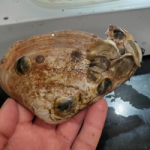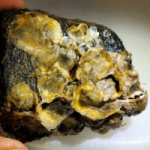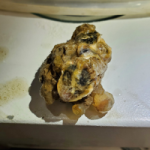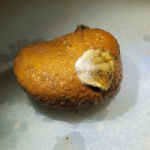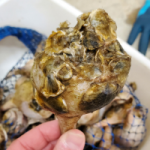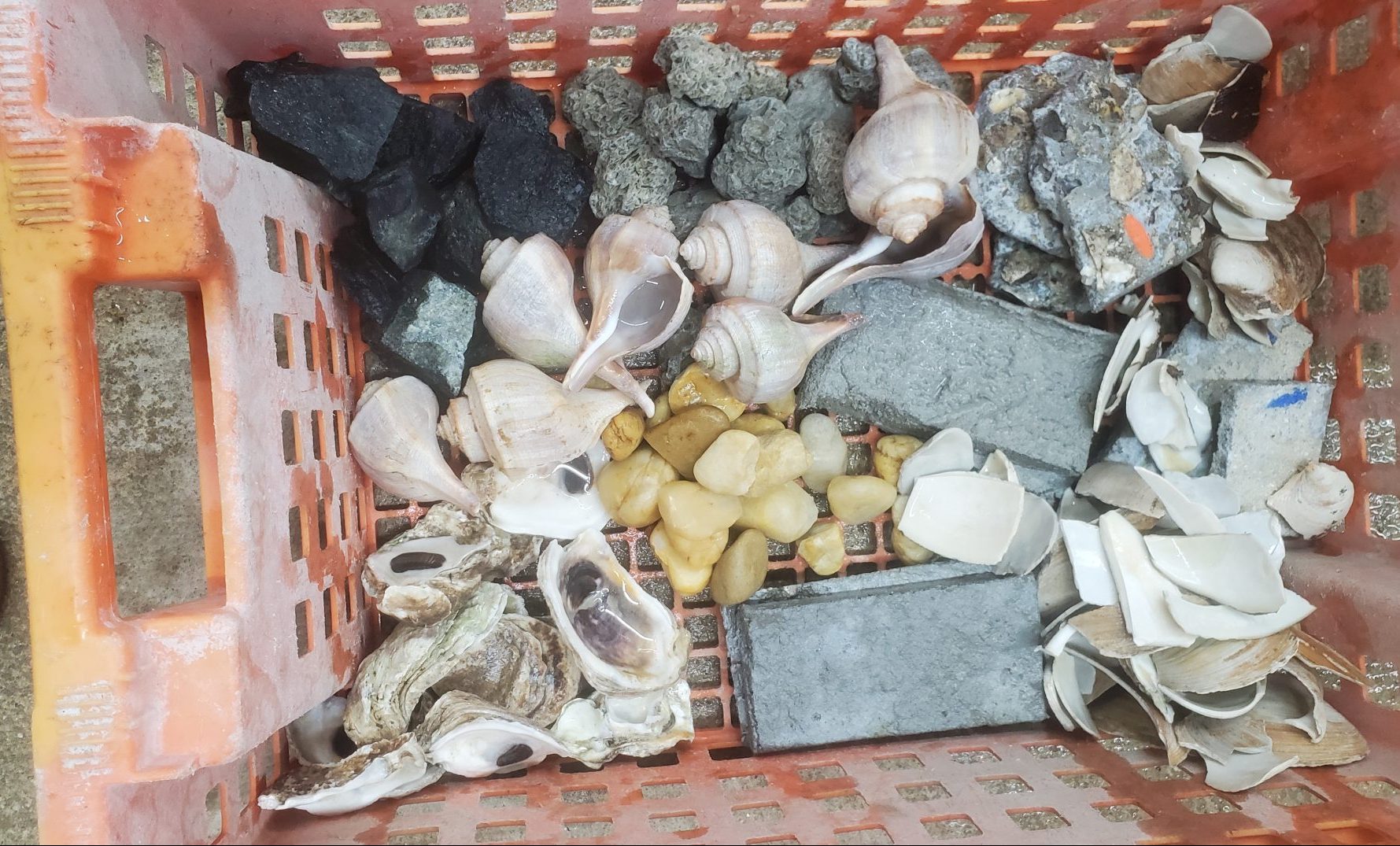
The Growing Demand for Oyster Shell
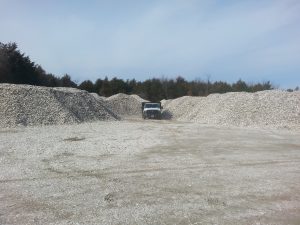
Shell pile at ORP’s Horn Point facility in Cambridge, MD used for sanctuary restoration plantings.
As the US oyster production industry expands along the East and Gulf Coasts, the demand for oyster shells—a crucial resource necessary to enhance production—has surged, far surpassing supply. Maryland’s oyster production industry includes private oyster aquaculture, a managed public oyster fishery, and oyster restoration. Currently, Maryland’s entire oyster production industry relies on recycled oyster shells to maintain healthy reefs and produce oysters for harvest. At current capacity and scale, the collective oyster production needs in Maryland require 1.2-1.7 million bushels of shell a year (MDNR 2023). The success and growth of this industry is limited by the availability of recycled oyster shell.
In Maryland, oyster shell is placed on the Chesapeake Bay seafloor to enhance or restore existing oyster habitat, or to create new habitat for leased oyster aquaculture. Shell is also used to create spat-on-shell by introducing hatchery-produced oyster larvae to recycled oyster shells, which are then deployed on existing oyster habitat. Spat-on-shell is central to Maryland’s oyster production process as many locations do not experience reliable natural oyster reproduction due to a lack of adult spawning oysters and variable environmental conditions (such as regional low salinity). The scarcity of shell poses a significant challenge to current oyster restoration, harvest repletion, and aquaculture efforts and threatens to slow progress if alternatives are not identified.
In response to this growing need, ORP is spearheading research and collaborative initiatives to explore the suitability and feasibility of integrating alternate substrates into the oyster production process.
Stakeholder and Regulatory Processes for Alternate Substrate
In 2022, ORP was tasked by the Maryland Aquaculture Coordinating Council to facilitate an Alternate Materials Workgroup to bring together stakeholders to evaluate current uses and options for alternate substrates and to evaluate knowledge gaps. The Workgroup was comprised of partners representing state, federal, NGO, scientific, and industry. The Workgroup developed recommendations for immediate and long-term implementation that were presented to the Maryland Department of Natural Resources (MDNR) in 2023. The Workgroup recommendations were also presented to a national group of oyster stakeholders participating in the Symposium on Alternative Substrate for Oysters hosted by the University of Maryland Center for Environmental Sciences (UMCES) in February 2024.
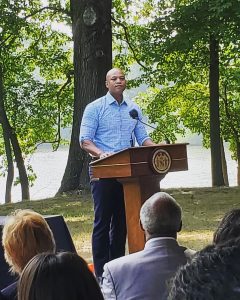
In 2023, in response to growing concerns from industry about the availability and need for alternate substrates, Governor Wes Moore signed executive order 01.01.2023.12 to establish a Shell and Substrate Task Force.
At the same time, Maryland Senate Bill 830/House Bill 1228 was passed by the Maryland General Assembly, which required MDNR to assess industry substrate needs and prepare a report to be submitted to the Governor. The recommendations from the ACC Workgroup provided a foundation for MDNR’s more expansive investigation. Combined, the ACC Workgroup and corresponding reports established a significant milestone in Maryland’s collaborative effort towards understanding substrate needs and available alternatives to shell.
One additional major milestone that occurred at this time was that MDNR submitted a revised permit application to the US Army Corps of Engineers to allow for the deployment of alternates to oyster shell in state waters. Once approved, this will allow for significant progress towards diversifying existing oyster production opportunities.
In 2023, in response to growing concerns from industry about the availability and need for alternate substrates, Governor Wes Moore signed executive order 01.01.2023.12 to establish a Shell and Substrate Task Force. The Task Force was comprised of various stakeholders, including key members representing the oyster industry. The Task Force was created to identify strategies and solutions to retain shell in Maryland, increase opportunities to use substrate alternates, and evaluate and provide recommendations on the economic impacts of using these substrates in the oyster fishery. ORP has been a key member of the Task Force and has provided expertise on substrate, shell acquisition, and oyster restoration. Of note, the Task Force has discussed and published a list of approved substrates for oyster production in Maryland, which will provide needed guidance to stakeholders seeking to integrate alternate substrates into their oyster production practices.
Research and Development Initiatives for Alternate Substrate
Another recommendation from the ACC’s Alternate Materials Workgroup was to test alternate substrates in the oyster production process, including assessing the logistical feasibility of integrating materials into existing production practices and assessing the biological suitability of the materials for oysters.
In 2023, ORP conducted a pilot study with the UMCES Horn Point Laboratory to assess oyster spat settlement efficiency and survival on a variety of materials that are currently used for oyster restoration in other states. These included: limestone marl, other biological shells (clam shell, whelk shell), river rock, granite, and concrete.
- Clam Shell
- Granite
- Limestone Marl
- River Rock
- Whelk Shell
This year, ORP and UMCES are building on this pilot study using funding allocated for research on alternate substrates from the SB830/HB1228. Experiments began in June and expanded our pilot study by testing spat settlement on additional substrates, evaluating chemical and physical properties of the substrates, and conducting a cost-benefit analysis. Next year, the project team will deploy spat-on-substrate in the water to assess long term oyster survival and growth. The results from this research will be used to prioritize specific materials that should be used in the oyster production process to create spat-on-shell alternates.
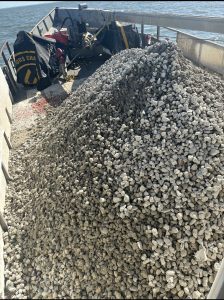
Recycled crushed concrete onboard the vessel, Robert Lee, prior to being deployed in Pocomoke Sound.
ORP has also conducted considerable market research to assess the cost, availability, and logistics of acquiring alternate substrates for oyster production, which will be integrated into the Shell and Substrate Task Force economic analysis and the UMCES cost-benefit analyses. Our market research has indicated that materials such as recycled crushed concrete can be more cost effective than recycled oyster shell for large-scale deployment. This finding has resulted in a growing interest from Maryland’s oyster industry to conduct field deployments of cheaper alternate materials. In June of this year, ORP, in partnership with MDNR and Somerset County Oyster and Shell Committee, deployed recycled crushed concrete adjacent to a shell planting in Pocomoke Sound to assess how concrete performs in the natural environment compared to natural oyster shell. The materials will be sampled during the MDNR Fall Survey this fall (2024) to assess the longevity of the substrate and spat recruitment between the two materials. MDNR is also working with other counties interested in deploying alternate materials on a pilot scale to apply for permits to replicate this in other tributaries. In the future, ORP plans to support these efforts by facilitating the deployment and testing the harvestability of alternate substrates on harvest reefs.
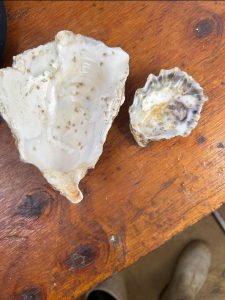
Pacific Oyster (Crassostrea gigas) seeded with Eastern Oyster (Crassostrea virginica) spat
Lastly, ORP has prioritized working with MDNR and private businesses to evaluate and acquire other sources of oyster shell to supplement the deficit of shells in the Chesapeake Bay region. For example, stakeholders have been able to take advantage of the surplus of recycled oyster shell from the Pacific Northwest, where there is a high production of oysters through aquaculture but a low demand for recycled shell for oyster substrate. Options such as this are valuable to help address immediate needs for substrate while other permitting and research are ongoing.
Overall, the insights gained from our ongoing collaborations, involvement in stakeholder discussions, and research initiatives have the potential to transform the future of oyster production in Maryland and our neighboring states. Integrating alternate substrates into oyster restoration, fishery, and aquaculture practices will significantly transform and expand oyster production potential. We are optimistic about the positive impacts that our collaborative approach and use of alternate substrates can have towards improving sustainable oyster harvest and building on existing successes for restoring oyster habitat and ecosystem function.
 We are immensely grateful to our donors and stakeholders for your continued support. Your investment in ORP fuels these groundbreaking initiatives, helping us lead the way in sustainable oyster production. Your support is vital in continuing our mission to restore, preserve, and expand this precious resource. Sign the Shell Recycling Pledge, and join us in making a difference!
We are immensely grateful to our donors and stakeholders for your continued support. Your investment in ORP fuels these groundbreaking initiatives, helping us lead the way in sustainable oyster production. Your support is vital in continuing our mission to restore, preserve, and expand this precious resource. Sign the Shell Recycling Pledge, and join us in making a difference!

